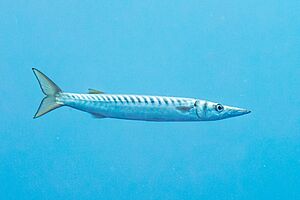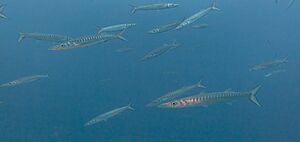Yellowmouth barracuda facts for kids
Quick facts for kids Yellowmouth barracuda |
|
|---|---|
 |
|
| Conservation status | |
| Scientific classification |
The yellowmouth barracuda, also known as the yellow barracuda, is a fast-swimming fish that loves to hunt. It belongs to the barracuda family and lives in the warm waters of the eastern Atlantic Ocean and the Mediterranean Sea. Sometimes, people confuse it with the European barracuda.
Contents
Meet the Yellowmouth Barracuda
The yellowmouth barracuda has a sleek, torpedo-shaped body. Its snout is long and pointed, and its mouth is full of two rows of sharp, fang-like teeth. Its lower jaw sticks out a bit.
You can tell it apart from the European barracuda by looking at its head. The yellowmouth barracuda does not have scales on a part of its cheek called the preoperculum. It also has many dark stripes across its back. These stripes usually go below its side line, which is a special line of sensors on a fish's body. These stripes fade away when the fish is no longer alive.
Adult yellowmouth barracudas are usually dark on top and shiny silver underneath. This is called countershading, and it helps them hide in the water. From above, their dark back blends with the deep water. From below, their light belly blends with the bright surface. Young barracudas are often dark yellow or greenish.
This barracuda is a bit smaller than its European cousin. It usually grows to about 35 to 40 centimeters (about 14 to 16 inches) long. However, some very large ones have been found, reaching over 1 meter (about 3.7 feet) in length!
Where Do They Live?
It can be a bit tricky to know exactly where yellowmouth barracudas live because they look so much like European barracudas. But we know they like the warm, subtropical parts of the eastern Atlantic Ocean. You can find them around islands like the Azores, Madeira, the Cape Verde Islands, and the Canary Islands.
They also live in the Mediterranean Sea. They have been seen near countries like Lebanon, Israel, Algeria, Corsica, and Sicily. They are also found in the Adriatic Sea and the Aegean Sea.
What Do They Eat?
Yellowmouth barracudas are fierce hunters! They mostly eat other fish. One study showed that a fish called the Blue jack mackerel was their favorite meal. They also eat other fish like bogues, ornate wrasses, and axillary sea breams. Sometimes, they even catch flying fish!
Barracudas are very fast when they hunt. They chase their prey quickly, and the hunt is usually over in less than a minute. They can hunt alone, but they are often more successful when they hunt in groups. They might pick out one fish or attack a whole group of fish. Besides fish, they sometimes eat squid and crabs.
Who Eats Them?
When yellowmouth barracudas are young, they can become food for other fish. For example, the lizard fish sometimes preys on young barracudas. This happens because young barracudas and lizard fish often live in the same calm, sandy bays.
How Do They Behave?
In the summer, yellowmouth barracudas often gather in large groups called schools. These schools can have up to 180 fish, but usually, they have about 30 to 40 fish. They like to form these schools in places where the water currents are strong.
In these schools, the smaller, younger fish tend to stay closer to the surface. The larger fish, which are usually females, swim deeper, sometimes as far down as 30 meters (about 100 feet). In winter, you only see small groups of young barracudas in shallow bays.
Barracudas form schools for several reasons:
- Safety: Being in a big group helps protect them from predators.
- Mating: It helps smaller males find larger females for reproduction.
- Hunting: As we learned, hunting in a group can make them more successful at catching food.
Interestingly, these barracudas don't seem to mix with other types of barracudas in their schools. But there have been reports of them swimming near huge whale sharks and even actively swimming towards manta rays!
Barracudas and People
People do catch yellowmouth barracudas, especially in the eastern Mediterranean Sea. Fishermen use special nets called trammel-nets and beach-seines to catch them.
Sometimes, they are sold in markets, like in Turkey. However, they are often caught by accident while fishermen are trying to catch other types of fish. As more yellowmouth barracudas appear in the Mediterranean, they might become a more important fish for local fishing.



